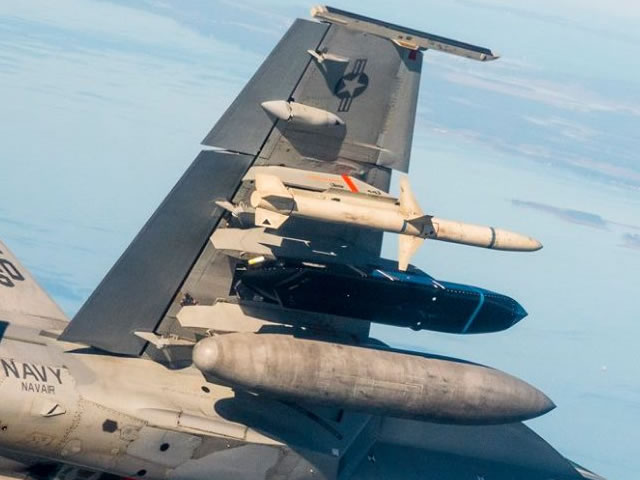Breaking news
SNA 2016: Lockheed Martin Announces Top Side Configuration for Surface Launched LRASM.
| 2016
 Successful
boosted test vehicle flight demonstrating LRASM missile egress, flight
with existing Mk-114 ASROCK booster and Mk-41 VLS canister design. Successful
boosted test vehicle flight demonstrating LRASM missile egress, flight
with existing Mk-114 ASROCK booster and Mk-41 VLS canister design. |
|||
"Lockheed
Martin is preparing to compete for OASuW Increment II competition in 2017"
Scott Callaway, Surface Launched LRASM Program Director, told us during
SNA 2016. In its deck mounted configuration, a LRASM launcher has the exact same footprint as a Harpoon launcher. It looks similar in form and shape as well: The LRASM missile fits inside a cylindrical canister positioned at an angle (just like the existing Harpoon launchers). The deck mounted LRASM shares the same MK 114 ASROCK booster as in the vertical launch variant. Lockheed Martin has already evaluated the console size requirements to accommodate LRASM and confirms the console would fit on the LCS frigate variant. Navy Recognition also learned that LRASM could potentially come with land attack capability. While this capability is not part of the current (OASuW increment I) set of requirements (increment II requirements have not been released yet), we were told that a software update would provide LRASM with such capability. This is because LRASM is based on the AGM-158 JASSM (Joint Air-to-Surface Standoff Missile) standoff land attack cruise missile. Scott Callaway concluded by telling us "Lockheed Martin is ready now for an at sea testing of LRASM in top side or Mk-41 VLS configuration". |
|||
 An
AGM-158C Long Range Anti-Ship Missile (LRASM) model integrated on F/A-18E/F
Super Hornet Jan. 6 at NAS Patuxent River, Md. The program's flight test
team is conducting testing to ensure proper loading, unloading and handling
of the LRASM on the F/A-18 E/F. (U.S. Navy photo) An
AGM-158C Long Range Anti-Ship Missile (LRASM) model integrated on F/A-18E/F
Super Hornet Jan. 6 at NAS Patuxent River, Md. The program's flight test
team is conducting testing to ensure proper loading, unloading and handling
of the LRASM on the F/A-18 E/F. (U.S. Navy photo) |
|||
In
the meantime, the U.S. Navy's NAVAIR (Naval Air Systems Command) announced
the end of the first phase of inflight loads testing for the air launched
LRASM program. With load testing completed, the U.S. Navy will now focus
on noise and vibration tests. We learned during SNA 2016 that jettison and live fire testing is planned to begin in 2017 with the B-1 and F/A-18E/F. Testing will continue until the early operational capabilities declaration in 2018 and 2019 respectively. The LRASM is a long-range subsonic cruise missile designed for better range and survivability than current anti-ship weaponry. It is carried with the wings and tail stowed and then deployed once released from the aircraft. This missile development program is a joint effort of the Defense Advanced Research Projects Agency, Naval Air Systems Command and the United States Air Force. To learn more: Link to LRASM Long Range Anti-Ship Missile technical datasheet |
|||


























